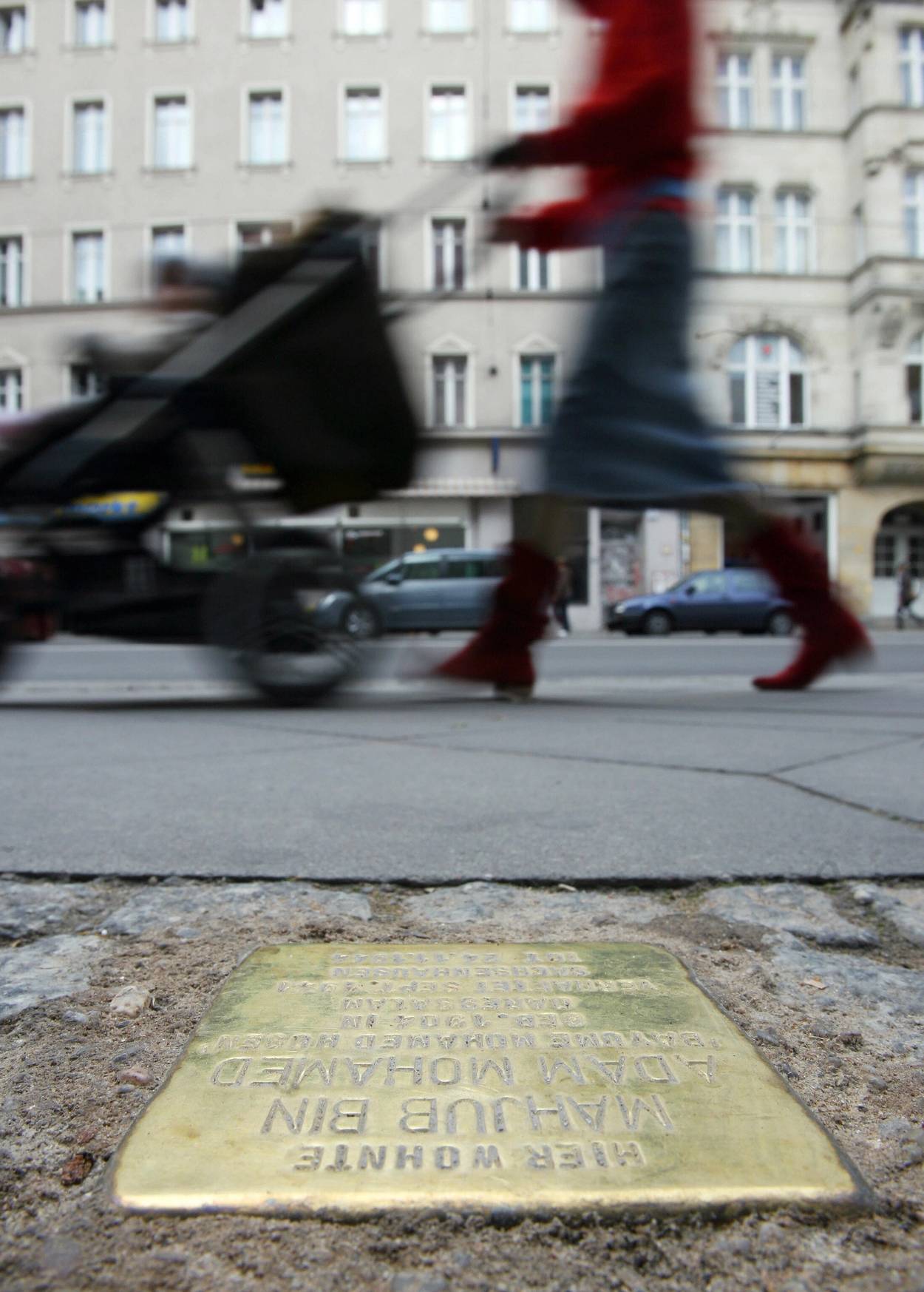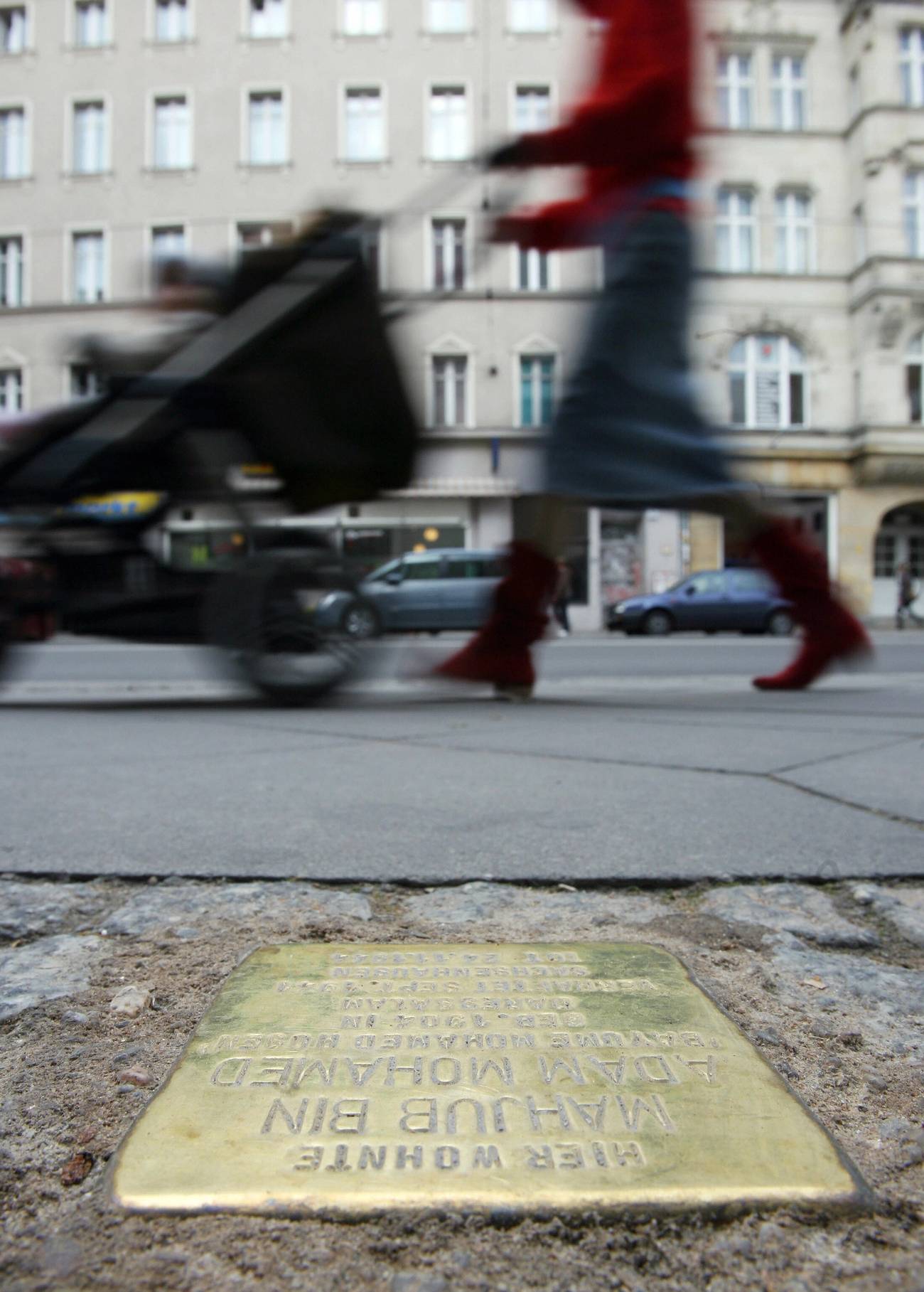Stumbling Over History in Berlin
Living in a city where reminders of the Holocaust are everywhere has given me unexpected opportunities to teach my children about the past




Walking down Alte Schönhauser Strasse in East Berlin, my 6-year-old son Sami looked down at the ground. He stopped at a Stolperstein (stumbling stone), one of many marking the residences of the Nazis’ victims throughout the city. “Who is this?” he asked, proceeding to sound out the letters one by one, connecting them into a first and last name: “D-a-v-i-d E-i-m-e-r. David Eimer,” he said with pride. In this moment and to this day, I take great pride not in Sami’s novel reading skills, but rather in the reverence he has built for the former Jewish dwellers of our neighborhood: how he, a child who rarely stands still, always stops to say their names.
As a Jewish New Yorker with Jewish German ancestors, I have long had an ambivalent relationship with Germany, my deep curiosity coupled with a sense of uncertainty and fear. In spite of the horrors, the ghosts that my Jewish elders had warned me of—my grandmother, sitting at her kitchen table in Hell’s Kitchen, once called Germany “the forbidden land”—I found myself drawn to the country. Its intellectual history, its Old World beauty, and its ongoing reckoning with the past have together called to me like a siren song.
Motivated by this curiosity and a desire to learn more about my own history, I took German language courses in college, studied abroad in Berlin, and then moved to Berlin for an internship when I graduated in 2006. Five years later, I found myself in Berlin yet again, this time living for two years in the city as I researched religious minority life for my Ph.D. and married a Berliner. In many ways, living in the German capital unsettled me. And yet at the same time, it rooted me more deeply in my Jewish identity. Reminders of the loss of Jewish life were scattered throughout my neighborhood, from the stumbling stones to signposts describing restrictions on Jews during the Third Reich. Being present amid so much absence made me feel responsible for bringing Jewish life back to Berlin; my son Sami, a giving of such life, was born on the outskirts of the city in 2014.
Our family moved to the United States when Sami was 1 so that I could finish my Ph.D. in sociology. We returned to Berlin only six months ago, at the height of the COVID-19 pandemic, when living in Germany felt like the safest choice. There remains for me a sense of redemption in being here, part of the plural fabric of this society. Still, the potentialities of raising my children in Germany (my younger child is now a toddler) evoked a long-held fear in me, regarding how to teach them about the country’s troubled past.
I don’t remember learning about the Holocaust myself. I must have been quite young, as I feel that I’ve always known this history intimately, that it has always been a part of me. I assume it was first made legible by the signs and symbols in my own urban neighborhood, the numbers on my neighbors’ arms, and in the stories—both first and second hand—told not to me, but in my presence, about what had happened “to them, to us.” I recall the difficulty of navigating a past that felt both mine and also so far outside of myself: belonging to another place and time, and yet, as my elders reiterated again and again, to all Jews.
Because this past has haunted me, producing a long shadow of worry cast over my life (as well as the lives of innumerable Jews), I made a pact with myself that I would hold off on teaching my own children about the Holocaust as long as I could. I didn’t have an exact age in mind, but imagined them adolescents, old enough to place this history squarely in the past. I knew they would feel its reverberations in their lives, and yet I yearned for them to remain somehow separate from it, to keep it apart from their hearts. I worried it would make them afraid of being Jewish, as it had once made me, or, even worse, entirely shatter their faith in humanity.
In the United States, Holocaust history is taught in schools. It is displayed in museums. And it is held in the bodies of the last survivors. In Berlin, it is everywhere. The apartment in which we reside today sits squarely in the Scheunenviertel (Barn Quarter), a formerly working-class Jewish neighborhood, which is therefore also a neighborhood of memorials. These memorials are largely integrated into the cityscape, as often small reminders, in the stumbling stones beside our feet; a table with empty chairs at Koppenplatz, a nearby city square; or women carved from stone, huddled in embrace on Rosenstrasse, their faces marked with what appear as tears. There are reminders, in the shape of such presences and also so many absences, of the Jewish life that was and then wasn’t, and now is—somehow—here, in us, again.
In Berlin, as I learned long ago, the signs and symbols of this past are a present and visible part of the cityscape, and thus have quickly become a present and visible part of our lives. This everywhere-ness of the past in our present has given me an unexpected opportunity to teach my son about the Holocaust far earlier than I had planned. It has opened a path to this history that both emerges from, and merges with, our surroundings. That some of the first words Sami read were the names of a Jewish neighbor in another time speaks of, and to, this opportunity: one of approaching what felt like an impossible task through the tangible signs that mark our urban neighborhood.
The city, the Scheunenviertel in particular, has become an unexpected partner in teaching my child lessons from Germany’s Jewish past: telling difficult, wrenching stories, but also signaling a sense of hope that still remains. That the city has risen as a partner in this painful undertaking has somehow made it easier for me. Today, when I walk to the local playground with Sami, he jumps across the cracks in the sidewalk, intermittently landing next to Stolpersteine marked with the names that he reads with increasing confidence and enduring reverence. When we indulge in Berliners—a name not here referencing the city’s denizens, but rather doughnuts bursting with jam—we sit in the Jewish cemetery on Grosse Hamburgerstrasse, where both Moses Mendelssohn, father of the Haskalah, and thousands of Nazi victims are buried.
When we are in the graveyard, I often think of my Jewish grandmother’s more reassuring words, made all the more powerful in their rarity. I recall how she told me that in Judaism graveyards are not simply places of death but also places of ceaseless life. This graveyard, like this neighborhood, in this city of a once-forbidden country that I have come to call my home, is a site not only of death, but also life. In fact, right here once stood a Jewish elderly home, and later a Jewish school. Now cairn, piles of rocks symbolizing eternal life, are stacked next to the haunting memorial outside of the cemetery gates, and we, my children and I, perched on the benches within its bounds—symbols of the continuity of Jewish life.
While teaching my son, I have also come to learn alongside him; I have come to realize that the closeness and visibility of the worst of history disarms its power over us. We live in conversation with, rather than silent fear of it, as we stumble upon its traces in our every day. This realization has allowed me to move beyond my fear of how to open a window into this past for my children, how to ease them into knowing this truth without breaking them.
So, too, has the parallel recognition that our history here in Germany is so much more than this. It is one of loss, but one of giving, too. Here my son will come to know these layered Jewish pasts, not only that of the Holocaust but also the Haskalah and more: pasts of persecution and migration, of music and prose. In fact, each time we exit the cemetery on Grosse Hamburgerstrasse, I read Sami the words, written by Moses Mendelssohn, etched on its outer wall, words that he will soon be able to read himself. “Discover truth, love beauty, seek goodness, do the best one can.” (“Nach Wahrheit forschen, Schönheit lieben, Gutes wollen, das Beste tun”). And I remind him that these words—these hopes—they belong to us, too.
Elisabeth Becker is a sociologist, currently the Freigeist Fellow at Heidelberg University.